Articles
- Page Path
- HOME > J Korean Acad Nurs > Volume 45(1); 2015 > Article
-
Review Article
- Dysphagia Screening Measures for Use in Nursing Homes: A Systematic Review
- Yeon-Hwan Park, Hwal Lan Bang, Hae-Ra Han, Hee-Kyung Chang
-
Journal of Korean Academy of Nursing 2015;45(1):1-13.
DOI: https://doi.org/10.4040/jkan.2015.45.1.1
Published online: February 27, 2015
1College of Nursing, Seoul National University, Seoul, Korea.
2The Research Institute of Nursing Science, Seoul National University, Seoul, Korea.
3School of Nursing, Johns Hopkins University, Baltimore, Maryland, USA.
4Seoul Women's College of Nursing, Seoul, Korea.
- Address reprint requests to: Bang, Hwal Lan. The Research Institute of Nursing Science, Seoul National University, 103 Daehak-ro, Jongno-gu, Seoul 110-799, Korea. Tel: +82-2-740-8493 Fax: +82-2-408-1877, luvlucie@snu.ac.kr
© 2015 Korean Society of Nursing Science
This is an Open Access article distributed under the terms of the Creative Commons Attribution NoDerivs License. (http://creativecommons.org/licenses/by-nd/4.0/) If the original work is properly cited and retained without any modification or reproduction, it can be used and re-distributed in any format and medium.
Abstract
-
Purpose
- The purpose of this study was to evaluate the psychometric quality and feasibility of measurements for screening dysphagia in older adults to identify the 'right tool' for nurses to use in nursing homes.
-
Methods
- A systematic review was done. Electronic databases were searched for studies related to dysphagia screening measurements. A checklist was used to evaluate the psychometric quality and applicability. Tools were evaluated for feasible incorporation into routine care by nurses.
-
Results
- 29 tools from 31 studies were identified. Dysphagia screening tools with an acceptable validity and reliability had sensitivity between 68% and 100% and specificity between 52% and 100%. The Gugging Swallowing Screen (GUSS) and the Standardized Swallowing Assessment (SSA) were the tools with high psychometric quality, especially with high sensitivity, that nurses could perform feasibly to identify the risk and to grade the severity of dysphagia and aspiration of nursing home residents.
-
Conclusion
- Results show that GUSS and SSA are reliable and sensitive tools for screening dysphagia which nurses can use in nursing homes. Further research is needed to examine feasibility of screening with identified tools, and also, to establish effective and standardized protocols for these tools so they can be effectively incorporated into routine care.
INTRODUCTION
METHODS
1) Assessment of the methodological quality of the studies
2) Assessment of the measurement properties of the dysphagia screening tools
3) Assessment of the applicability of dysphagia screening tools in NHs
RESULTS
DISCUSSION
CONCLUSION
This research was supported by Basic Science Research Program through the National Research Foundation of Korea (NRF) funded by the Ministry of Education, Science and Technology (2010-0003738).
- 1. Marik PE, Kaplan D. Aspiration pneumonia and dysphagia in the elderly. Chest. 2003;124(1):328–336. ArticlePubMed
- 2. Tanner DC. Lessons from nursing home dysphagia malpractice litigation. J Gerontol Nurs. 2010;36(3):41–46. Article
- 3. Park YH, Han HR, Oh BM, Lee J, Park JA, Yu SJ, et al. Prevalence and associated factors of dysphagia in nursing home residents. Geriatr Nurs. 2013;34(3):212–217. ArticlePubMed
- 4. Murry T, Carrau RL. Clinical manual of swallowing disorders. 2nd ed. San Diego, CA: Plural Publishing; 2006.
- 5. Krueger W, Conlon B. Comparison of dysphagia competency procedures in medical and school settings. In: The annual Convention of the American Speech-Language-Hearing Association; 2006 November 16-18; Miami, FL.
- 6. Beverly C, Burger SG, Maas ML, Specht JK. Aging issues: Nursing imperatives for healthcare reform. Nurs Adm Q. 2010;34(2):95–109. PubMed
- 7. Werner H. The benefits of the dysphagia clinical nurse specialist role. J Neurosci Nurs. 2005;37(4):212–215.ArticlePubMed
- 8. Bours GJ, Speyer R, Lemmens J, Limburg M, de Wit R. Bedside screening tests vs. videofluoroscopy or fibreoptic endoscopic evaluation of swallowing to detect dysphagia in patients with neurological disorders: Systematic review. J Adv Nurs. 2009;65(3):477–493. ArticlePubMed
- 9. Travers PL. Poststroke dysphagia: Implications for nurses. Rehabil Nurs. 1999;24(2):69–73. ArticlePubMed
- 10. Hawker S, Payne S, Kerr C, Hardey M, Powell J. Appraising the evidence: Reviewing disparate data systematically. Qual Health Res. 2002;12(9):1284–1299. ArticlePubMedPDF
- 11. Terwee CB, Bot SD, de Boer MR, van der Windt DA, Knol DL, Dekker J, et al. Quality criteria were proposed for measurement properties of health status questionnaires. J Clin Epidemiol. 2007;60(1):34–42. ArticlePubMed
- 12. Martino R, Silver F, Teasell R, Bayley M, Nicholson G, Streiner DL, et al. The Toronto bedside swallowing screening test (TOR-BSST): Development and validation of a dysphagia screening tool for patients with stroke. Stroke. 2009;40(2):555–561. ArticlePubMed
- 13. Burns N, Grove SK. The practice of nursing research: Appraisal, synthesis, and generation of evidence. 7th ed. St. Louis, MO: Saunders; 2013.
- 14. Bot SD, Terwee CB, van der Windt DA, Bouter LM, Dekker J, de Vet HC. Clinimetric evaluation of shoulder disability questionnaires: A systematic review of the literature. Ann Rheum Dis. 2004;63(4):335–341. ArticlePubMedPMC
- 15. Westergren A. Detection of eating difficulties after stroke: A systematic review. Int Nurs Rev. 2006;53(2):143–149. ArticlePubMed
- 16. Marques CH, de Rosso AL, André C. Bedside assessment of swallowing in stroke: Water tests are not enough. Top Stroke Rehabil. 2008;15(4):378–383. ArticlePubMed
- 17. Antonios N, Carnaby-Mann G, Crary M, Miller L, Hubbard H, Hood K, et al. Analysis of a physician tool for evaluating dysphagia on an inpatient stroke unit: The modified mann assessment of swallowing ability. J Stroke Cerebrovasc Dis. 2010;19(1):49–57. ArticlePubMed
- 18. Hiss SG, Postma GN. Fiberoptic endoscopic evaluation of swallowing. Laryngoscope. 2003;113(8):1386–1393. ArticlePubMed
- 19. Perry L, Love CP. Screening for dysphagia and aspiration in acute stroke: A systematic review. Dysphagia. 2001;16(1):7–18. ArticlePubMedPDF
- 20. Ramsey DJ, Smithard DG, Kalra L. Early assessments of dysphagia and aspiration risk in acute stroke patients. Stroke. 2003;34(5):1252–1257. ArticlePubMed
- 21. Intercollegiate Stroke Working Party. National clinical guidelines for stroke. 4th ed. London, UK: Royal College of Physicians; 2012.
- 22. Lindsay P, Bayley M, Hellings C, Hill M, Woodbury E, Phillips S. Canadian best practice recommendations for stroke care (updated 2008). CMAJ. 2008;179(12):S1–S25. ArticlePMC
- 23. Han TR, Paik NJ, Park JW. Quantifying swallowing function after stroke: A functional dysphagia scale based on videofluoroscopic studies. Arch Phys Med Rehabil. 2001;82(5):677–682. ArticlePubMed
- 24. Trapl M, Enderle P, Nowotny M, Teuschl Y, Matz K, Dachenhausen A, et al. Dysphagia bedside screening for acute-stroke patients: The Gugging swallowing screen. Stroke. 2007;38(11):2948–2952. ArticlePubMed
- 25. Perry L. Screening swallowing function of patients with acute stroke. Part one: Identification, implementation and initial evaluation of a screening tool for use by nurses. J Clin Nurs. 2001;10(4):463–473. ArticlePubMed
- 26. Logemann JA, Veis S, Colangelo L. A screening procedure for oropharyngeal dysphagia. Dysphagia. 1999;14(1):44–51.ArticlePubMedPDF
- 27. Lambert HC, Gisel EG. The assessment of oral, pharyngeal and esophageal dysphagia in elderly persons. Phys Occup Ther Geriatr. 1997;14(4):1–25.Article
- 28. Whiting PF, Rutjes AW, Westwood ME, Mallett S, Deeks JJ, Reitsma JB, et al. QUADAS-2: A revised tool for the quality assessment of diagnostic accuracy studies. Ann Intern Med. 2011;155(8):529–536. ArticlePubMed
- 29. Smithard DG, O'Neill PA, England RE, Park CL, Wyatt R, Martin DF, et al. The natural history of dysphagia following a stroke. Dysphagia. 1997;12(4):188–193.ArticlePubMedPDF
REFERENCES
Appendix
Psychometric Data of the Screening Instruments
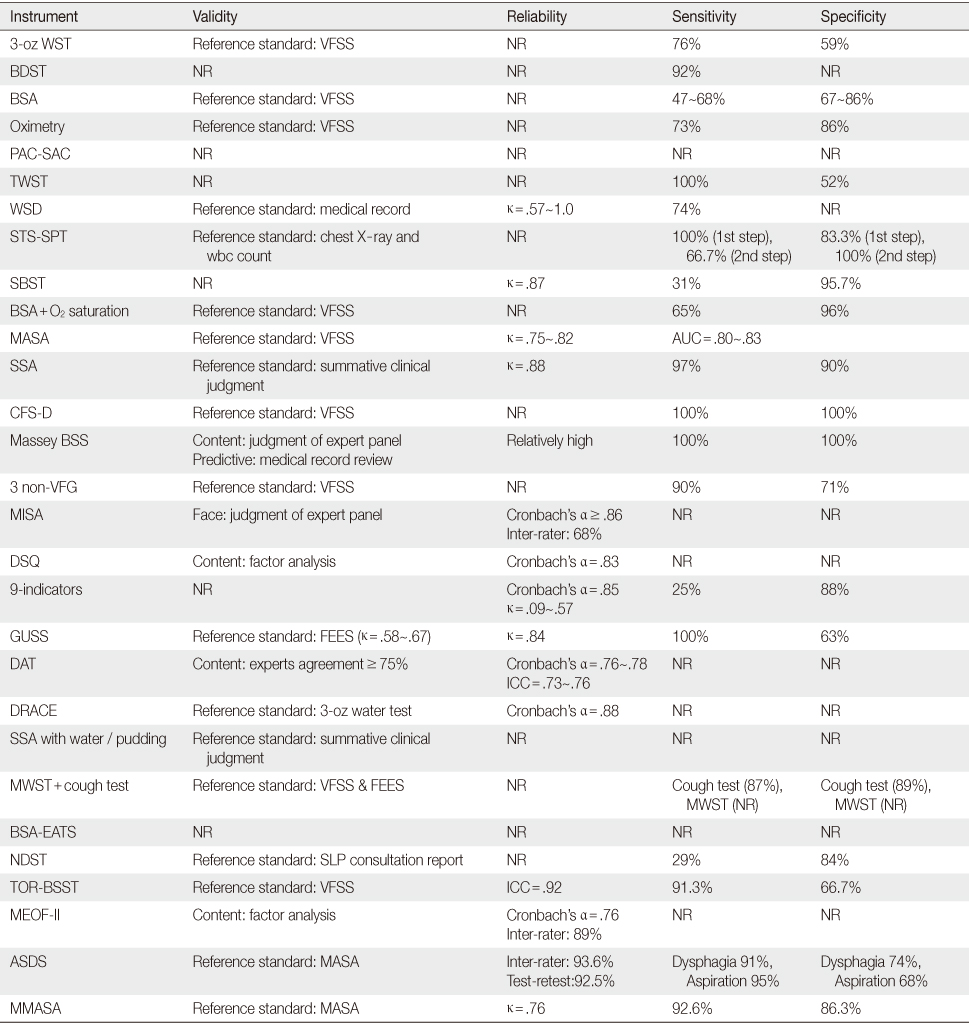
3-oz WST=3-oz Water Swallow Test; 3 non-VFG=Three non-Videofluorography Test (water + food test + x-ray); 9-indicators=9-Clinical Indicators of Dysphagia; ASDS=Acute-Stroke Dysphagia Screen; AUC=Area under the ROC curve; BDST=Burke Dysphagia Screening Test; BSA=Bedside Swallowing Assessment; BSA + O2 saturation=Combination of Bedside Swallowing Assessment and Oxygen Saturation Monitoring; BSA-EATS=Bedside Swallow Assessment-EATS (Examine Ability To Swallow); CFS-D=Clinical Functional Scale for Dysphagia; DAT=Dysphagia Assessment Tool; DRACE=Dysphagia Risk Assessment for the Community Dwelling Elderly; DSQ=Dysphagia Screening Questionnaire; FEES=Fiberoptic Endoscopic Evaluation of Swallowing; GUSS=Gugging Swallowing Screen; MASA=Mann Assessment of Swallowing Ability; Massey BSS=The Massey Bedside Swallowing Screen; MEOF-II=Minimal Eating Observation Form II; MISA=McGill Ingestive Skills Assessment; MMASA=Modified Mann Assessment of Swallowing Ability; MWST + cough test=Modified Water Swallowing Test + Cough Test; NDST=Nursing Dysphagia Screening Tool; NR=Not reported; PAC-SAC=PAC (prefeeding assessment checklist)- SAC (swallowing assessment checklist); SBST=Simple Bedside Swallowing Test; SLP=Speech Language Pathologist; SSA=Standardized Swallowing Assessment; SSA with water/pudding=Standardized Swallowing Assessment with water/pudding; STS-SPT=Simple Two-Step Swallowing Provocation Test; TOR-BSST=Toronto Bedside Swallowing Screening Test; TWST=Timed Water Swallowing Test; VFSS=Videofluoroscopic Swallowing Study; wbc=White blood cell; WSD=Westergen's Screening for Dysphagia.
Quality Rating and Evaluation of the Applicability of the Screening Instruments
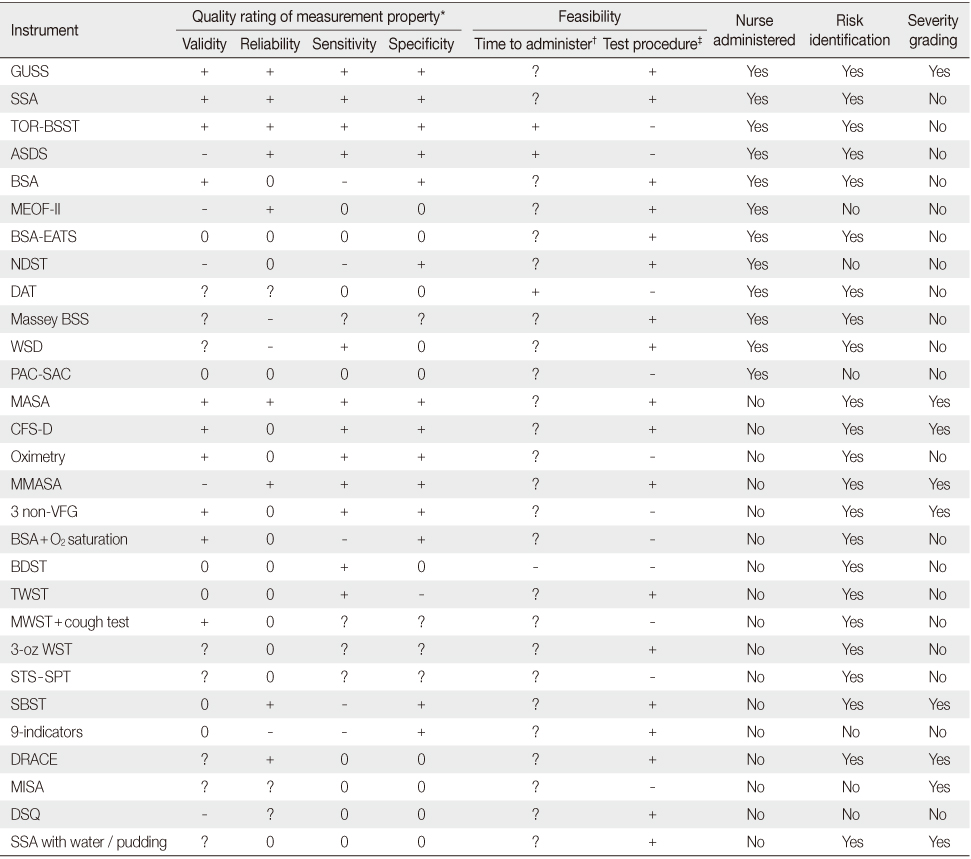
*Quality rating of measurement property (+=Positive; ?=Indeterminate; -=Negative; 0=No information available); †Time to administer (+=Less than 10 minutes; -=More than 10 minutes; ?=Time to administer unknown); ‡Test procedure (+=Trial swallow only; -=Procedures and instruments needed other than trial swallows); 3-oz WST=3-oz Water Swallow Test; 3 non-VFG=Three non-Videofluorography Test (water + food test + x-ray); 9-indicators=9-Clinical Indicators of Dysphagia; ASDS=Acute-Stroke Dysphagia Screen; BDST=Burke Dysphagia Screening Test; BSA=Bedside Swallowing Assessment; BSA + O2 saturation=Combination of Bedside Swallowing Assessment and Oxygen Saturation Monitoring; BSA-EATS=Bedside Swallow Assessment- EATS (Examine Ability To Swallow); CFS-D=Clinical Functional Scale for Dysphagia; DAT=Dysphagia Assessment Tool; DRACE=Dysphagia Risk Assessment for the Community Dwelling Elderly; DSQ=Dysphagia Screening Questionnaire; GUSS=Gugging Swallowing Screen; MASA=Mann Assessment of Swallowing Ability; Massey BSS=The Massey Bedside Swallowing Screen; MEOFII=Minimal Eating Observation Form II; MISA=McGill Ingestive Skills Assessment; MMASA=Modified Mann Assessment of Swallowing Ability; MWST + cough test=Modified Water Swallowing Test + Cough Test; NDST=Nursing Dysphagia Screening Tool; PAC-SAC=PAC (prefeeding assessment checklist)- SAC (swallowing assessment checklist); SBST=Simple Bedside Swallowing Test; SSA=Standardized Swallowing Assessment; SSA with water/pudding=Standardized Swallowing Assessment with water/pudding; STS-SPT=Simple Two-Step Swallowing Provocation Test; TOR-BSST=Toronto Bedside Swallowing Screening Test; TWST=Timed Water Swallowing Test; WSD=Westergen's Screening for Dysphagia.
Figure & Data
REFERENCES
Citations

- eTWST: An Extension to the Timed Water Swallow Test for Increased Dysphagia Screening Accuracy
Louise Brage, Fredrik Nylén, Patricia Hägglund, Thorbjörn Holmlund
Dysphagia.2025; 40(4): 801. CrossRef - Evaluation of the performance of screening tools for dysphagia in older adults: A diagnostic meta-analysis
Lingli Zhang, Ran Hou, Lin Liu, Yan Liu, Qinqin Yu
Geriatric Nursing.2025; 61: 629. CrossRef - Effect of artificial intelligence-based video-game system on dysphagia in patients with stroke: A randomized controlled trial
Bohan Zhang, Ka Po Wong, Mingyue Liu, Vivian Hui, Cai Guo, Zihan Liu, Yue Liu, Qian Xiao, Jing Qin
Clinical Nutrition.2025; 45: 81. CrossRef - Progress on aspiration assessment methods for patients after esophageal cancer surgery in early: A review
Yushuang Su, Yan Li, Zhongbin Chen, Hong Gao, Yaxie He, Xiaohua Li, Xiaying Zeng, Wei Lan, Qin Yang
Medicine.2025; 104(3): e41214. CrossRef - Reliability and validity of the Standardized swallowing assessment among community-dwelling older adults in China
Jing Wang, Caixia Chen, Yuzhen Qin, Jing Zeng, Chunhua Zhang, Liugen Wang, Heping Li, Xi Zeng
Annals of Medicine.2025;[Epub] CrossRef - Occurrence of impaired swallowing ability and change over a year in older adults living in nursing homes
Ida Crossler, Clara Shrestha Jensen, Karin Eriksson, Lisa Tuomi
Scientific Reports.2025;[Epub] CrossRef - Feasibility of Oral Function Evaluation According to Dementia Severity in Older Adults with Alzheimer’s Disease
Maki Shirobe, Ayako Edahiro, Keiko Motokawa, Shiho Morishita, Yoshiko Motohashi, Chiaki Matsubara, Masanori Iwasaki, Yutaka Watanabe, Hirohiko Hirano
Nutrients.2024; 16(7): 992. CrossRef - Research trends on dysphagia among Korean older adults in long-term care facilities: A scoping review
Seyoung Cho, Dukyoo Jung, Jisung Park
Journal of Korean Gerontological Nursing.2024; 26(2): 134. CrossRef - Appropriate volumes of water for non-invasive swallowing assessments of nursing home residents: A descriptive correlational study
Meng Rung Tsai, Wann Yun Shieh, Hsiu Hsin Tsai, Yea Ing Lotus Shyu, Kuo Hsuan Chang, Fur Hsing Wen, Chia Yih Liu
Heliyon.2024; 10(17): e37340. CrossRef - Aspiration pneumonia in nursing literature—a mapping review
Dominika Lisiecka, Áine Kearns, William Evans, Dawn Farrell
Frontiers in Rehabilitation Sciences.2024;[Epub] CrossRef - Development and validation of a nomogram for predicting dysphagia in long-term care facility residents
Jinmei Liu, Mingshu Liao, Hui Yang, Xiaofang Chen, Yang Peng, Jing Zeng
Aging Clinical and Experimental Research.2023; 35(6): 1293. CrossRef - Understanding how primary care practitioners can be supported to recognise, screen and initially diagnose oropharyngeal dysphagia: protocol for a behavioural science realist review
Caroline Smith, Debi Bhattacharya, Sion Scott
BMJ Open.2023; 13(2): e065121. CrossRef - Effects of chin tuck against resistance exercise on post-stroke dysphagia rehabilitation: A systematic review and meta-analysis
Jing Liu, Qiuyi Wang, Jing Tian, Wanqiong Zhou, Yitian Gao, Xuemei Chen, Wei Zhang, Yajing Gao, Lanshu Zhou
Frontiers in Neurology.2023;[Epub] CrossRef - Development and validation of a predictive model for patients with post-extubation dysphagia
Jia-ying Tang, Xiu-qin Feng, Xiao-xia Huang, Yu-ping Zhang, Zhi-ting Guo, Lan Chen, Hao-tian Chen, Xiao-xiao Ying
World Journal of Emergency Medicine.2023; 14(1): 49. CrossRef - Evaluation of preventive care for swallowing difficulty through policy changes in Japanese long-term care insurance: analysis of a nationwide claims dataset for long-term care insurance
Hiroko Mori, Ayako Nakane, Haruka Tohara, Takeo Nakayama
BMC Health Services Research.2023;[Epub] CrossRef - Are Oropharyngeal Dysphagia Screening Tests Effective in Preventing Pneumonia?
Ikuko Okuni, Satoru Ebihara
Journal of Clinical Medicine.2022; 11(2): 370. CrossRef - Altered Brain Function Activity in Patients With Dysphagia After Cerebral Infarction: A Resting-State Functional Magnetic Resonance Imaging Study
Lei Li, Jiayu Liu, Fenxiong Liang, Haidong Chen, Rungen Zhan, Shengli Zhao, Tiao Li, Yongjun Peng
Frontiers in Neurology.2022;[Epub] CrossRef - The Role of Instrumental Swallowing Assessment in Adults in Residential Aged Care Homes: A National Modified Delphi Survey Examining Beliefs and Practices
Olga Birchall, Michelle Bennett, Nadine Lawson, Susan M. Cotton, Adam P. Vogel
Dysphagia.2022; 37(3): 510. CrossRef - Predicting feeding-tube dependence in patients following endotracheal extubation: a two-item swallowing screen
Shu-Fen Siao, Wen-Hsuan Tseng, Tyng-Guey Wang, Yu-Chung Wei, Tzu-Yu Hsiao, Shih-Chi Ku, Cheryl Chia-Hui Chen
BMC Pulmonary Medicine.2021;[Epub] CrossRef - European white paper: oropharyngeal dysphagia in head and neck cancer
Laura W. J. Baijens, Margaret Walshe, Leena-Maija Aaltonen, Christoph Arens, Reinie Cordier, Patrick Cras, Lise Crevier-Buchman, Chris Curtis, Wojciech Golusinski, Roganie Govender, Jesper Grau Eriksen, Kevin Hansen, Kate Heathcote, Markus M. Hess, Sefik
European Archives of Oto-Rhino-Laryngology.2021; 278(2): 577. CrossRef - Dysphagia screening in residential care settings: A scoping review
Constantino Estupiñán Artiles, Julie Regan, Claire Donnellan
International Journal of Nursing Studies.2021; 114: 103813. CrossRef - A Swallowing Screening Test Enhances a Better Recognition of Patients with a Hip Fracture at Risk for Oropharyngeal Dysphagia
Hugo Wijnen, Peter P. Schmitz, Martine Jansen, Linda Hendrix, Job L. C. van Susante, Hanna Willems
Orthopaedic Nursing.2021; 40(2): 94. CrossRef - Comparison studies of ultrasound-guided botulinum toxin injection and balloon catheter dilatation in the treatment of neurogenic cricopharyngeal muscle dysfunction
Shuo Luan, Shao-Ling Wu, Ling-Jun Xiao, Hai-Yun Yang, Mei-Xin Liao, Shao-Ling Wang, Sheng-Nuo Fan, Chao Ma
NeuroRehabilitation.2021; 49(4): 629. CrossRef - Instrumental Swallowing Assessment in Adults in Residential Aged Care Homes: A Scoping Review
Olga Birchall, Michelle Bennett, Nadine Lawson, Susan M. Cotton, Adam P. Vogel
Journal of the American Medical Directors Association.2021; 22(2): 372. CrossRef - Validation of the Munich Swallowing Score (MUCSS) in patients with neurogenic dysphagia: A preliminary study
G. Bartolome, U. Starrost, H. Schröter-Morasch, B. Schilling, L. Fischbacher, L. Kues, S. Graf, W. Ziegler
NeuroRehabilitation.2021; 49(3): 445. CrossRef - Dietary inflammatory index is associated with pain intensity and some components of quality of life in patients with knee osteoarthritis
Vahideh Toopchizadeh, Neda Dolatkhah, Dawood Aghamohammadi, Mahrokh Rasouli, Maryam Hashemian
BMC Research Notes.2020;[Epub] CrossRef - Dysphagia and mealtime difficulties in dementia: Speech and language therapists’ practices and perspectives
Aisling Egan, Carolyn Andrews, Anja Lowit
International Journal of Language & Communication Disorders.2020; 55(5): 777. CrossRef - The Gugging Swallowing Screen in dysphagia screening for patients with stroke: A systematic review
Ki Deok Park, Tae Hee Kim, Seon Heui Lee
International Journal of Nursing Studies.2020; 107: 103588. CrossRef - Optimising Medicines Administration for Patients with Dysphagia in Hospital: Medical or Nursing Responsibility?
David J. Wright, David G. Smithard, Richard Griffith
Geriatrics.2020; 5(1): 9. CrossRef - Risk Factors of Dysphagia Among Community-Dwelling Middle-Aged Women
Young Hee Lee, Dukyoo Jung, Ok Jong Yun, Hyesoon Lee, Minkyung Lee
Gastroenterology Nursing.2020; 43(2): 164. CrossRef - Developing and Testing the Diagnostic Accuracy of a Brief Nursing Dysphagia Screen
Sarah Groppo-Lawless, Claire C. Davies, Alex Lengerich
Rehabilitation Nursing.2020; 45(6): 367. CrossRef - The Easy Dysphagia Symptom Questionnaire (EDSQ): a new dysphagia screening questionnaire for the older adults
Kyeong Eun Uhm, Minsun Kim, Yong Min Lee, Bo-Ram Kim, Yoon-Sook Kim, Jaekyung Choi, Seol-Heui Han, Hee Joung Kim, Kwang Ha Yoo, Jongmin Lee
European Geriatric Medicine.2019; 10(1): 47. CrossRef - Sarcopenia is an Independent Risk Factor for Dysphagia in Community-Dwelling Older Adults
Seungwoo Cha, Won-Seok Kim, Ki Woong Kim, Ji Won Han, Hak Chul Jang, Soo Lim, Nam-Jong Paik
Dysphagia.2019; 34(5): 692. CrossRef - The GUSS test as a good indicator to evaluate dysphagia in healthy older people: a multicenter reliability and validity study
Ebru Umay, Sibel Eyigor, Ali Yavuz Karahan, Ilknur Albayrak Gezer, Ayse Kurkcu, Dilek Keskin, Gulten Karaca, Zeliha Unlu, Canan Tıkız, Meltem Vural, Banu Aydeniz, Ebru Alemdaroglu, Emine Esra Bilir, Ayse Yalıman, Ekin Ilke Sen, Mazlum Serdar Akaltun, Ozle
European Geriatric Medicine.2019; 10(6): 879. CrossRef - Repetitive Saliva Swallowing Test: Norms, Clinical Relevance and the Impact of Saliva Secretion
Emmelie Persson, Inger Wårdh, Per Östberg
Dysphagia.2019; 34(2): 271. CrossRef - Dysphagia in Frail Older Persons: Making the Most of Current Knowledge
Nicole Rogus-Pulia, Rainer Wirth, Philip D. Sloane
Journal of the American Medical Directors Association.2018; 19(9): 736. CrossRef - Frailty, Swallowing and Dysphagia
David G. Smithard, Mariyam Shazra, Dharinee Hansjee, Ian Swaine
Current Physical Medicine and Rehabilitation Reports.2018; 6(3): 192. CrossRef - Nursing interventions in adult patients with oropharyngeal dysphagia: a systematic review
Lorena Molina, Susana Santos-Ruiz, Pere Clavé, Luis González-de Paz, Esther Cabrera
European Geriatric Medicine.2018; 9(1): 5. CrossRef - Nursing home-acquired pneumonia, dysphagia and associated diseases in nursing home residents: A retrospective, cross-sectional study
Vanessa R.Y. Hollaar, Gert-Jan van der Putten, Claar D. van der Maarel-Wierink, Ewald M. Bronkhorst, Bert J.M. de Swart, Cees de Baat, Nico H.J. Creugers
Geriatric Nursing.2017; 38(5): 437. CrossRef - Oropharyngeal dysphagia: manifestations and diagnosis
Nathalie Rommel, Shaheen Hamdy
Nature Reviews Gastroenterology & Hepatology.2016; 13(1): 49. CrossRef - Dysphagia and Aspiration
John E. Morley
Journal of the American Medical Directors Association.2015; 16(8): 631. CrossRef - Expanding Instrumental Options for Dysphagia Diagnosis and Research: Ultrasound and Manometry
Maggie-Lee Huckabee, Phoebe Macrae, Kristin Lamvik
Folia Phoniatrica et Logopaedica.2015; 67(6): 269. CrossRef
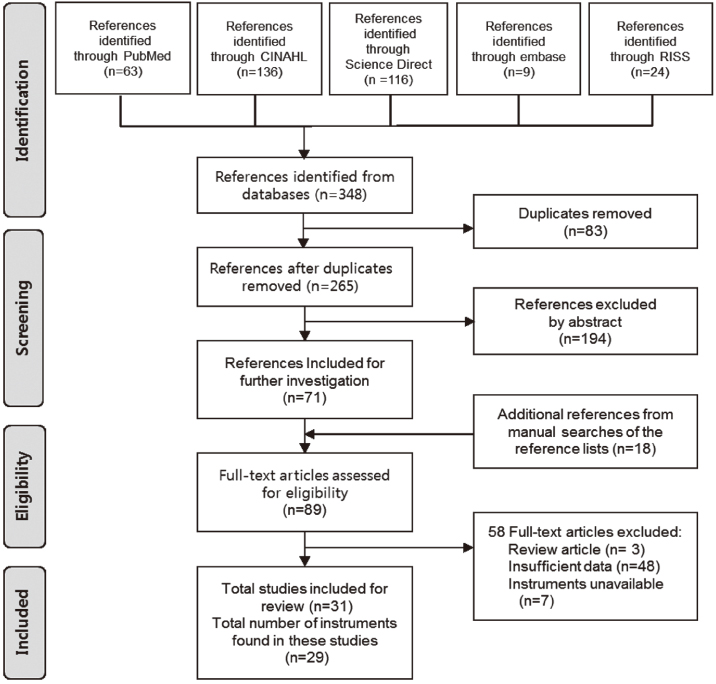
Figure 1
Methodological Quality of the Studies (N=31)
Characteristics of the Studies and Measurements Included in Systematic Review (N=29)
Asp. Pneu.=Aspiration pneumonia; DR=Doctor; D/W=Distilled water; GCS=Glasgow Coma Scale; Hx=History; NR=Not reported; RN=Registered nurse; SLP=Speech language pathologist; SLT=Speech language therapist; s/s=Sign and symptom; VFG=Videofluorography.
Psychometric Data of the Screening Instruments
3-oz WST=3-oz Water Swallow Test; 3 non-VFG=Three non-Videofluorography Test (water + food test + x-ray); 9-indicators=9-Clinical Indicators of Dysphagia; ASDS=Acute-Stroke Dysphagia Screen; AUC=Area under the ROC curve; BDST=Burke Dysphagia Screening Test; BSA=Bedside Swallowing Assessment; BSA + O2 saturation=Combination of Bedside Swallowing Assessment and Oxygen Saturation Monitoring; BSA-EATS=Bedside Swallow Assessment-EATS (Examine Ability To Swallow); CFS-D=Clinical Functional Scale for Dysphagia; DAT=Dysphagia Assessment Tool; DRACE=Dysphagia Risk Assessment for the Community Dwelling Elderly; DSQ=Dysphagia Screening Questionnaire; FEES=Fiberoptic Endoscopic Evaluation of Swallowing; GUSS=Gugging Swallowing Screen; MASA=Mann Assessment of Swallowing Ability; Massey BSS=The Massey Bedside Swallowing Screen; MEOF-II=Minimal Eating Observation Form II; MISA=McGill Ingestive Skills Assessment; MMASA=Modified Mann Assessment of Swallowing Ability; MWST + cough test=Modified Water Swallowing Test + Cough Test; NDST=Nursing Dysphagia Screening Tool; NR=Not reported; PAC-SAC=PAC (prefeeding assessment checklist)- SAC (swallowing assessment checklist); SBST=Simple Bedside Swallowing Test; SLP=Speech Language Pathologist; SSA=Standardized Swallowing Assessment; SSA with water/pudding=Standardized Swallowing Assessment with water/pudding; STS-SPT=Simple Two-Step Swallowing Provocation Test; TOR-BSST=Toronto Bedside Swallowing Screening Test; TWST=Timed Water Swallowing Test; VFSS=Videofluoroscopic Swallowing Study; wbc=White blood cell; WSD=Westergen's Screening for Dysphagia.
Quality Rating and Evaluation of the Applicability of the Screening Instruments
*Quality rating of measurement property (+=Positive; ?=Indeterminate; -=Negative; 0=No information available); †Time to administer (+=Less than 10 minutes; -=More than 10 minutes; ?=Time to administer unknown); ‡Test procedure (+=Trial swallow only; -=Procedures and instruments needed other than trial swallows); 3-oz WST=3-oz Water Swallow Test; 3 non-VFG=Three non-Videofluorography Test (water + food test + x-ray); 9-indicators=9-Clinical Indicators of Dysphagia; ASDS=Acute-Stroke Dysphagia Screen; BDST=Burke Dysphagia Screening Test; BSA=Bedside Swallowing Assessment; BSA + O2 saturation=Combination of Bedside Swallowing Assessment and Oxygen Saturation Monitoring; BSA-EATS=Bedside Swallow Assessment- EATS (Examine Ability To Swallow); CFS-D=Clinical Functional Scale for Dysphagia; DAT=Dysphagia Assessment Tool; DRACE=Dysphagia Risk Assessment for the Community Dwelling Elderly; DSQ=Dysphagia Screening Questionnaire; GUSS=Gugging Swallowing Screen; MASA=Mann Assessment of Swallowing Ability; Massey BSS=The Massey Bedside Swallowing Screen; MEOFII=Minimal Eating Observation Form II; MISA=McGill Ingestive Skills Assessment; MMASA=Modified Mann Assessment of Swallowing Ability; MWST + cough test=Modified Water Swallowing Test + Cough Test; NDST=Nursing Dysphagia Screening Tool; PAC-SAC=PAC (prefeeding assessment checklist)- SAC (swallowing assessment checklist); SBST=Simple Bedside Swallowing Test; SSA=Standardized Swallowing Assessment; SSA with water/pudding=Standardized Swallowing Assessment with water/pudding; STS-SPT=Simple Two-Step Swallowing Provocation Test; TOR-BSST=Toronto Bedside Swallowing Screening Test; TWST=Timed Water Swallowing Test; WSD=Westergen's Screening for Dysphagia.
Asp. Pneu.=Aspiration pneumonia; DR=Doctor; D/W=Distilled water; GCS=Glasgow Coma Scale; Hx=History; NR=Not reported; RN=Registered nurse; SLP=Speech language pathologist; SLT=Speech language therapist; s/s=Sign and symptom; VFG=Videofluorography.
3-oz WST=3-oz Water Swallow Test; 3 non-VFG=Three non-Videofluorography Test (water + food test + x-ray); 9-indicators=9-Clinical Indicators of Dysphagia; ASDS=Acute-Stroke Dysphagia Screen; AUC=Area under the ROC curve; BDST=Burke Dysphagia Screening Test; BSA=Bedside Swallowing Assessment; BSA + O2 saturation=Combination of Bedside Swallowing Assessment and Oxygen Saturation Monitoring; BSA-EATS=Bedside Swallow Assessment-EATS (Examine Ability To Swallow); CFS-D=Clinical Functional Scale for Dysphagia; DAT=Dysphagia Assessment Tool; DRACE=Dysphagia Risk Assessment for the Community Dwelling Elderly; DSQ=Dysphagia Screening Questionnaire; FEES=Fiberoptic Endoscopic Evaluation of Swallowing; GUSS=Gugging Swallowing Screen; MASA=Mann Assessment of Swallowing Ability; Massey BSS=The Massey Bedside Swallowing Screen; MEOF-II=Minimal Eating Observation Form II; MISA=McGill Ingestive Skills Assessment; MMASA=Modified Mann Assessment of Swallowing Ability; MWST + cough test=Modified Water Swallowing Test + Cough Test; NDST=Nursing Dysphagia Screening Tool; NR=Not reported; PAC-SAC=PAC (prefeeding assessment checklist)- SAC (swallowing assessment checklist); SBST=Simple Bedside Swallowing Test; SLP=Speech Language Pathologist; SSA=Standardized Swallowing Assessment; SSA with water/pudding=Standardized Swallowing Assessment with water/pudding; STS-SPT=Simple Two-Step Swallowing Provocation Test; TOR-BSST=Toronto Bedside Swallowing Screening Test; TWST=Timed Water Swallowing Test; VFSS=Videofluoroscopic Swallowing Study; wbc=White blood cell; WSD=Westergen's Screening for Dysphagia.
*Quality rating of measurement property (+=Positive; ?=Indeterminate; -=Negative; 0=No information available); †Time to administer (+=Less than 10 minutes; -=More than 10 minutes; ?=Time to administer unknown); ‡Test procedure (+=Trial swallow only; -=Procedures and instruments needed other than trial swallows); 3-oz WST=3-oz Water Swallow Test; 3 non-VFG=Three non-Videofluorography Test (water + food test + x-ray); 9-indicators=9-Clinical Indicators of Dysphagia; ASDS=Acute-Stroke Dysphagia Screen; BDST=Burke Dysphagia Screening Test; BSA=Bedside Swallowing Assessment; BSA + O2 saturation=Combination of Bedside Swallowing Assessment and Oxygen Saturation Monitoring; BSA-EATS=Bedside Swallow Assessment- EATS (Examine Ability To Swallow); CFS-D=Clinical Functional Scale for Dysphagia; DAT=Dysphagia Assessment Tool; DRACE=Dysphagia Risk Assessment for the Community Dwelling Elderly; DSQ=Dysphagia Screening Questionnaire; GUSS=Gugging Swallowing Screen; MASA=Mann Assessment of Swallowing Ability; Massey BSS=The Massey Bedside Swallowing Screen; MEOFII=Minimal Eating Observation Form II; MISA=McGill Ingestive Skills Assessment; MMASA=Modified Mann Assessment of Swallowing Ability; MWST + cough test=Modified Water Swallowing Test + Cough Test; NDST=Nursing Dysphagia Screening Tool; PAC-SAC=PAC (prefeeding assessment checklist)- SAC (swallowing assessment checklist); SBST=Simple Bedside Swallowing Test; SSA=Standardized Swallowing Assessment; SSA with water/pudding=Standardized Swallowing Assessment with water/pudding; STS-SPT=Simple Two-Step Swallowing Provocation Test; TOR-BSST=Toronto Bedside Swallowing Screening Test; TWST=Timed Water Swallowing Test; WSD=Westergen's Screening for Dysphagia.
 KSNS
KSNS
 E-SUBMISSION
E-SUBMISSION
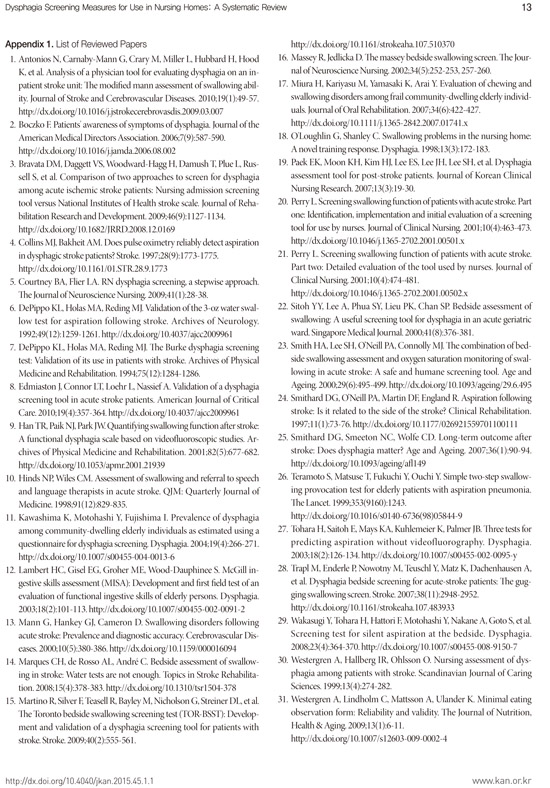

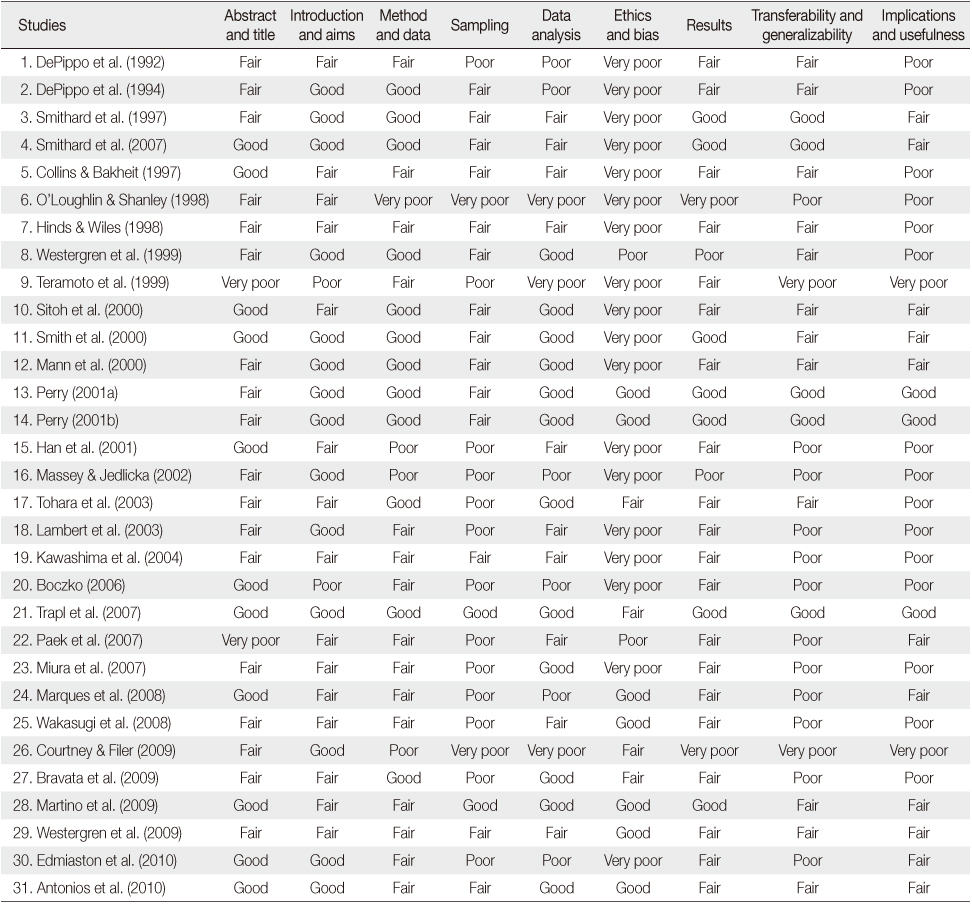
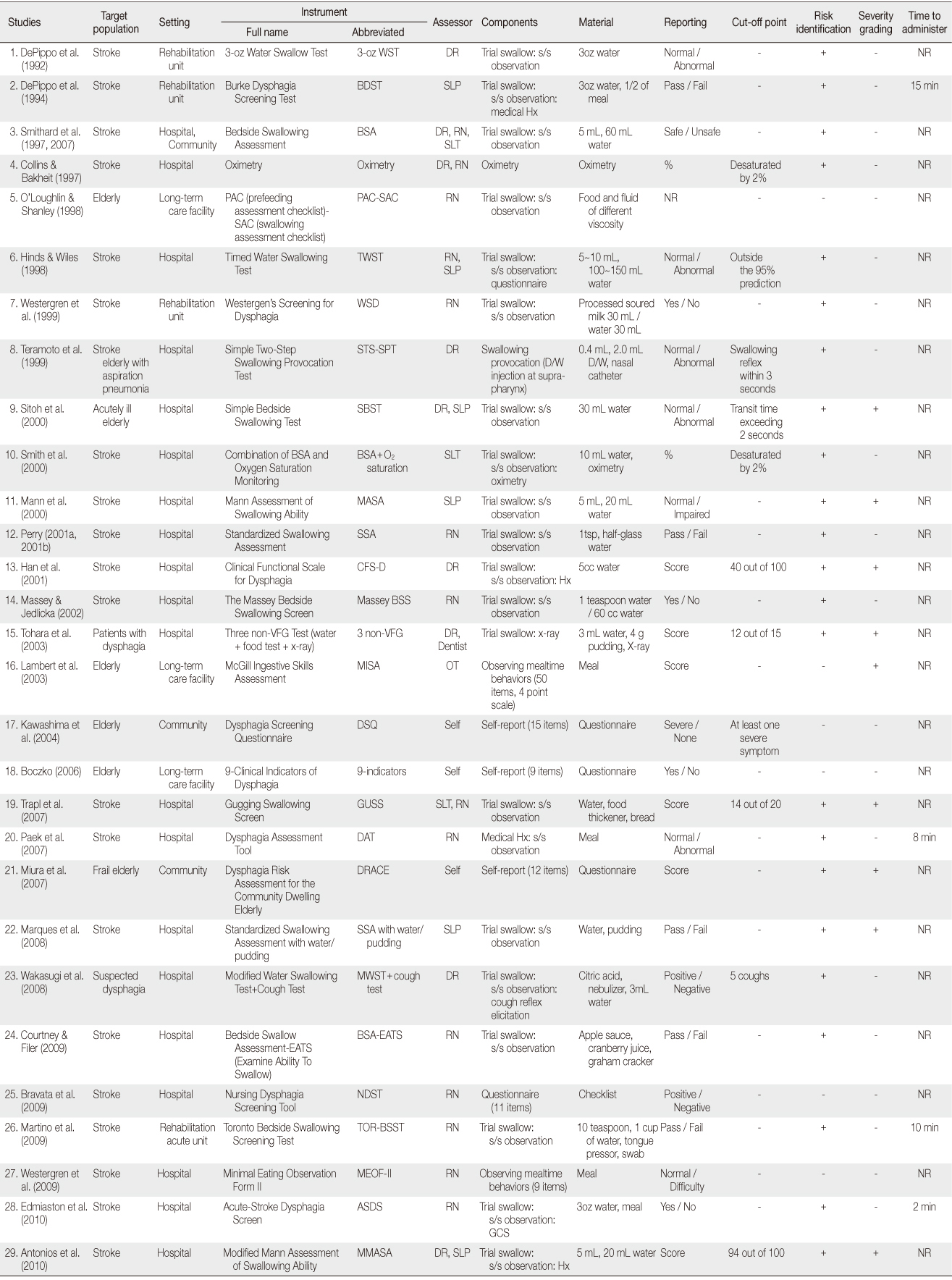
 Cite
Cite

